« BACK
Lewis Humphrey Roberts (1831-1915)
continued...
SECOND MARRIAGE date: Monday, 10 August 1868.
Place: Arsenal Street Methodist Episcopal Church (also sometimes known as First Methodist Episcopal Church), Watertown, NY; married at the parsonage by the Rev. S. R. Fuller, Pastor.
Proof of this marriage comes from a certificate attached to the General Affidavit of Ellen A. Roberts’ application for a Civil War Widow’s Pension (1916):
This is to Certify that in a book of Official Records kept by the pastors of Arsenal St. Methodist Episcopal Church, Watertown, NY the following entry appears under heading of marriages performed by Rev. S.R. Fuller. “1868 Aug 10th Lewis Roberts - Ellen A Roberts both of Sackets Harbor. At parsonage two friends of the parties present & Mrs. Fuller & Flora Embury.” Rev. S.R. Fuller was paster [sic] of this Church in the year 1868. (signed) D.F. Pierce, Pastor of Arsenal St. Methodist Episcopal Church Watertown N.Y. Watertown N.Y. Aug 10th 1904.
Ellen Roberts was 22 years old at the time of their wedding; Lewis Roberts was around 37 years old. But it was not unusual at that time for a young woman who wanted a life as a wife and mother to marry an older man or a disabled soldier, since so many men had been killed or maimed in the war that courtship choices for women were reduced. Lewis and Ellen had probably met when she was working at the “Camp Home” at Madison Barracks while Lewis was stationed there as regimental clerk/bookkeeper. Ellen, a resident of the small village of Sackets Harbor, adjacent to the Army’s Madison Barracks, was no prior relation to Lewis, although they shared the same surname. Perhaps that fact prompted their first conversation.
The Arsenal Street/First Methodist Episcopal Church is today the First United Methodist Church of Watertown. The church building (and parsonage?) at the time of Lewis and Ellen’s marriage was located on Arsenal Street downtown (reportedly near where the original Woolworth’s store would later be situated). This church and its contents were destroyed by fire in 1880, and a new and larger church building was erected on the same spot in 1881. Lewis and Ellen’s daughter, Clara, would be married in the same parsonage in 1890. (Here is a postcard of the church as it looked around 1904 when Pastor Pierce signed the proof of marriage certificate (above) on what was Lewis and Ellen’s 36th wedding anniversary. This church building was destroyed by fire on 3 February 1942. For more images and maps of historical Watertown, NY click here.)
We now know that this was actually Lewis Roberts’ second wedding. In fact, we now know that he was committing bigamy by marrying Ellen Roberts, since his first wife, Margaret Davies Roberts, was still alive and living in Milwaukee and that their divorce would not be enacted until October 1870. In her divorce complaint Margaret swore she had never been able to determine Lewis’ whereabouts, despite writing in 1870 to his family members and to Army military authorities. No wonder they wouldn’t talk! Lewis, for his part, did seem to be hiding his past. He would in later life claim in at least three different Civil War pension application documents that Ellen was his first and only wife. Evidently no one in the Pension Office checked such details very closely.
I wonder if Ellen or their children ever knew of or ever suspected Lewis’ earlier marriage. Though he didn’t tell the Pension Office, did he ever tell them? When the Old Soldier was regaling his daughters with stories of his long, colorful, well-traveled life, did he ever hint about another wife? After 47 years of marriage and having seven children together, was this a secret Lewis ever shared with Ellen?
SPOUSE’S name in full: Ellen A. ROBERTS (no prior relation), daughter of Otis Alexander ROBERTS and Esther Ann TOWNSEN(D)
After their wedding Ellen and Lewis remained in the Sackets Harbor area for at least a few months, until Lewis was “discharged on disability” from the Veterans Reserve Corps on 13 April 1869 and was free to leave Madison Barracks. He gave the Army a forwarding address of Utica, Oneida County, New York (where there lived another Lewis Roberts) but he did not go to live there.
CHILDREN:
Etta Grace ROBERTS (1869-1924)
Erwin W. ROBERTS (1871-1905)
Clara J. ROBERTS (1873-1941)
Wilbur H. ROBERTS (1875-1890)
Jerome Lewis (“Joe”) ROBERTS (1879-1939)
Elleanor Mary (“Nellie”) ROBERTS (1882-1952)
Elizabeth Alice (“Bessie”) ROBERTS (1884-1962)
(See Roberts Family Descendants’ Chart)
Island life
According to a 1938 newspaper article containing recollections of Lewis and Ellen’s daughter, Clara (Watertown Daily Times, Aug. 6, 1938), Lewis and Ellen moved to Big Galloup Island soon after they were married (probably shortly after he received his discharge from the Army at Madison Barracks). Today known as Big Galloo Island (about 2,216 acres within the jurisdiction of Hounsfield Town, Jefferson County), it lies in Lake Ontario next to Little Galloo Island, about 10-15 miles west of Sackets Harbor and Henderson Harbor. At that time “Big Galloup” had a new lighthouse and was the home of a handful of farmers and men working in the timber industry, harvesting the trees on the island into lumber and boards which were then taken away by sailing schooners or steamboats.
With a post office address of Sackets Harbor, the Robertses lived halfway between the head and the foot of Big Galloup Island for about ten years, from around mid-1869 until around the Fall of 1880. About 14 families lived on the island then, including the Gannetts, the Johnsons (who took care of the island’s lighthouse), the Wattams, the Westcotts, some Hennessys, a schoolteacher and her elderly mother, and Ellen’s brother, Jerome ROBERTS, and their father, Otis Alexander ROBERTS, who had come there from Michigan with his family to live in the forest that covered half the island. His job there was to cut down and haul the trees to the island’s sawmill, using oxen.
Lewis once more worked as a “machinist,” for he ran the 15-horsepower stationary steam engine at the large sawmill located at the head of the island, which operated during the six warmer months of the year. In addition he “chored around” the house, gathered wood, and fed cattle. Surrounded by family and congenial neighbors, his young wife, Ellen Roberts, began having babies and later claimed that Galloup Island was ‘the best place she ever lived in and that it was the happiest time in her life.’
I have also since wondered if Lewis Roberts had been as happy and contented there as well. Perhaps living a primitive and isolated island existence suited him, and perhaps even reminded him favorably of his younger days spent near the relatively isolated, island-studded northwestern coast of Wales. I have also wondered if he was attempting, in his new life as an illicitly-married-man and father, to get as far away as he possibly could from detection by his first wife, Margaret.
The 1870 census, taken 2 August, shows the family living on Galloo Island as “Lewellen” Roberts, age 32 (he was actually approaching 40), “works in sawmill,” and born in Massachusetts, with Ellen, age 24, “keeping house,” and their baby, Etta, age 1 (both born in New York). In their own home not far off were Ellen’s father, Otis Roberts, age 49, a “laborer,” born in New York, with (his second wife) Sophia, age 28 and born in Canada, keeping house; Ellen’s brothers Jerome (17) and Lillard (15), working in the sawmill and born in Ohio; and Otis and Sophia’s son, James, one month old, born in May of that year in New York State.
The 1880 census taken 10 years later on 25 June shows the Robertses still living on the island, with both families further enlarged. Lewis Roberts, age 44 (actually he was almost 50) was listed as working as an “Engineer” in the mill; his wife, Ellen age 34, was keeping house, and they now had five small children: Etta (10), Erwin (9), Clara (7), Wilber (5), and Louis (Jerome Lewis), age 1. Still living nearby were Ellen’s father, Otis Roberts, age 55 (“Works in Sawmill”), wife Sophia (35), keeping house, three sons, Jerome (26, works in sawmill), James (10), and George (7), and a daughter, Elizabeth (5). All the children in Otis’ home were now claimed to have been born in New York State.
(For more on Sackets Harbor and Galloo Island history and genealogy, see the excellent Hounsfield History.Net website at USGenNet.)
The Watertown years
Sometime around the summer of 1879 or 1880, Lewis went to stay at the home in Watertown of his friend from Galloo Island, Morris Hennessy, while he searched for a suitable home of his own in Watertown into which he could relocate his family. Why Lewis decided to leave Galloo Island I do not know, although his daughter Clara’s 1938 newspaper interview claimed that after the Galloo Island years he got a job in Watertown at the Taggart Brothers paper mill. The Taggart Bros. Co. had its office at Morrison Street, Watertown, and its pulp and paper mill at Felts Mills, NY, about eight miles distant. It specialized in the manufacture of manilla, newsprint, and paper bags.
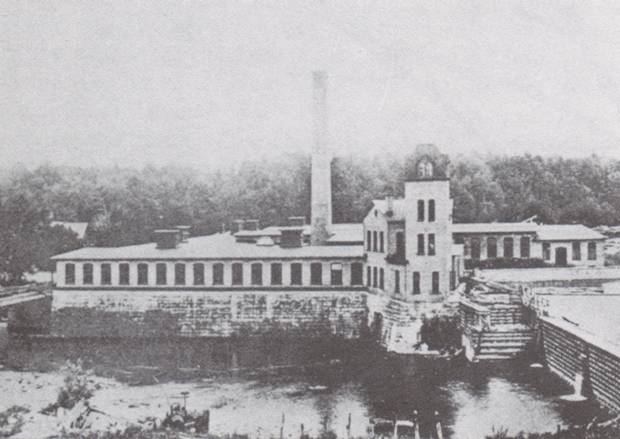
Taggart Paper Company mill, Felts Mills, New York. From John A. Haddock’s Growth of a Century: An Illustrated History of Jefferson County, New York, 1793-1894.
Watertown, a growing industrial, railroading, and mill city straddling the Black River, was the county seat and largest city in Jefferson County. The 1882-1883 Watertown city directory shows Lewis H. Roberts, mechanic, residing at 165 Main Street, Watertown (on the north side of the Black River). The family from now on would live in Watertown, the children would grow up there, and it was there that Ellen and Lewis’s two youngest children were born: Nellie in 1882, and Bessie in 1884, the year an electric light system was established in Watertown.
At some point prior to or around 1887, the family moved again, settling in a modest but nice residential neighborhood on the north side of town. Their new address was 4 Cooper Street. Cooper Street ran north from 86 Main Street to Highland Avenue, and No. 4 was the first address on the east side of the street, across from the Cooper Street School (No. 5 Cooper Street), where little Nellie (and Jerome, and probably some of her other siblings too) went to school. Perhaps one of the reasons Lewis and Ellen moved their children to Watertown was so that they could have better schooling and better opportunities than were available to them on Galloo Island.
Many farmers in the surrounding countryside at that time were moving their families into Watertown for just these reasons, seeking better schooling for their children and better-paying jobs for themselves. The population of Watertown in 1880 was 10,697; by 1890 the city had grown to 14,725, and by 1900 the population would be 21,696. Certainly life in the “big city” of Watertown must have been quite a change for the family from the more primitive and isolated existence they had enjoyed in the midst of wild nature on the Big Galloup. But Lewis Roberts, a man who had crossed at least one ocean more than once, been all over the U.S., fought in the War, and lived in Boston, New York City, Milwaukee, and in Wales, would not have felt intimidated or out of place.
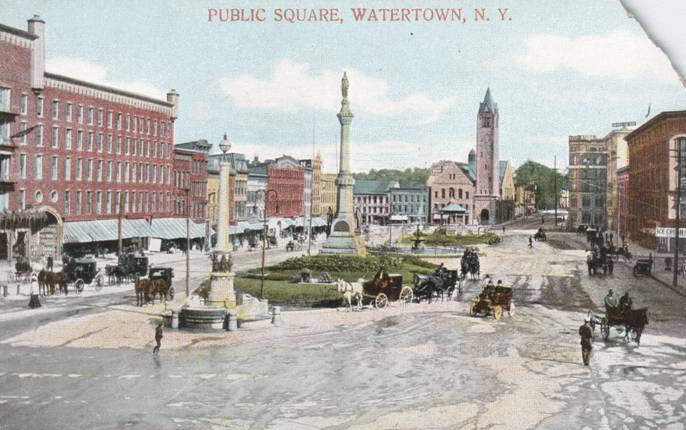
The public square of Watertown, New York, as it looked in horse and buggy days.
On 16 June 1887 Lewis Roberts filed his lengthy application for a Civil War invalid pension, in which he claimed he had been unable to work for the previous two years. His statement ended with these words: “I have tried to do light jobs about the Portable Engine works in this city in the Taggart Paper Mill and in the Babcock Buggy Company but was obliged to quit all these employments because I could not endure the work and for about two years last past have not been able to work at anything physical or mental. I have bought and used patent medicines from time to time. I have not employed physicians since my discharge because my brother and the surgeons in the V.R.C. told me that no treatment would help me.”
His application included supporting affidavits from his friend, Morris Hennessey, and his former neighbor and boss, Byron Johnson, both from Galloo Island days, as well as statements from Sackets Harbor residents John H. Reader, a boot and shoe dealer, and William H. Clark, an accountant who knew him from his Madison Barracks days. All of these men described Lewis’ disabilities (paralysis of right side, blindness in the right eye, and deafness in the right ear) and attested to their long-standing nature. Morris Hennessey added, “While he lived here in Watertown N.Y. from 1879 to the present time he has worked at odd jobs in machine shop, wagon shops and at such light work as he could do till he got so poorly in health that no one would hire him. He has not been able to do any kind of labor by reason of said diseases from a year and a half. He cannot earn anything and is dependent upon his friends and on others for help to support him.”
On 21 May 1888 Lewis Roberts wrote a letter home to his family from the Soldiers and Sailors Home in Bath (Steuben County), New York, about 165 miles away, where he was “temporarily stopping.” Another letter from him dated February 1888 to two ladies in Watertown (“Mrs. L and Mrs. R”—his wife and daughter Clara, perhaps?) whom he obviously knew well and could joke around with, has also survived in the family. We can infer from these missives that 1) his health may have taken so bad a turn for the worse that he had traveled to Bath to avail himself of the health care offered there by the G.A.R. and/or the Federal government to aging and disabled Civil War veterans, and 2) he remained a witty and playful character, even if in poor or failing health. It was also around this time that his 1864 conviction in Boston for desertion from the Army was reduced to the lesser charge of having been “absent without leave” and he was granted a Civil War pension at $8 per month. He was in his late 50’s at the time; his oldest child, Etta, was 18 years old, and his two youngest, Nellie and Bessie, were five and three. We can only imagine what his young wife, Ellen, must have felt then, having to raise a houseful of seven children by herself with her elderly husband disabled, unable to work, and absent from the home. It would have been good news to learn that on 24 April 1889 Lewis Robert’s pension payments were doubled by the government and raised from $8 to $16 a month.
On 23 February 1890, daughter Clara, Lewis’ third child, married young Jeremiah (“Jerry”) LaPatra at the “Arsenal Street Parsonage” in Watertown. (Was this the same Arsenal Street Methodist Episcopal parsonage where her parents had been married in 1868?). She was the first of their children to wed, and was a month shy of her 17th birthday.
Tragically, not long afterwards, on 15 April 1890, Lewis and Ellen’s fourth child, Wilbur H. Roberts, died at the age of 15 at their home at 4 Cooper Street of blood poisoning (no further details are known). His death must have been a terrible shock to the entire family. Ellen Roberts paid $15 to purchase a family plot at the nearby North Watertown Cemetery on Bradley Street for the burial, which might lead one to infer that Lewis was not in town or well enough to conduct such business at the time.
The Watertown city directory for that year lists Lewis Roberts as still living at #4 Cooper Street in Watertown. But the 1890 Special Census of Civil War Veterans [M123, Roll 107] shows him living that June at the National Soldiers Home (aka the National Home for Disabled Volunteer Soldiers, Southern Branch) near Hampton in Elizabeth City County, Virginia. There he is listed as Lewis Roberts, formerly a private in the 7th Wisconsin L.A. (Light Artillery), enlisted Sept. 1862, discharged July 1865 [sic], having served 2 years, 10 months (note that this is incorrect and incomplete information). His ‘disability incurred’ was described on the census form as “Bronchitis.” He was about 59 years old at that time.
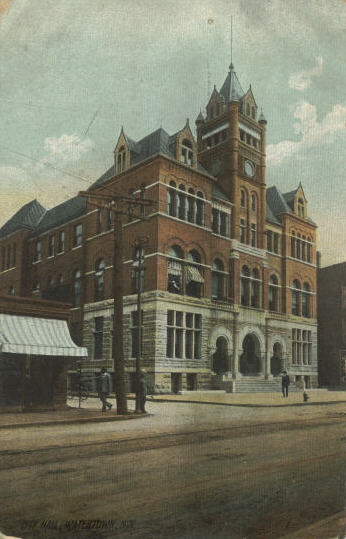
City Hall, Watertown, New York.
In the next few years, oldest daughter Etta Roberts would marry William A. Minor (or Miner), a railroad man, circa 1891 when she was around age 21, and would have two daughters by him (Agnes L. Minor, born 2 March 1892, and Bessie M. Minor, born 15 September 1893), making grandparents of Ellen and Lewis. William Minor would be sent to prison for four months in 1896 for knocking down a farmer while serving as doorkeeper at the firemen’s ball, and at some point he and Etta would be divorced. Around that time Etta subsequently married Harry Danks, at that time a railroad baggageman. Also in 1896 Clara and Jerry LaPatra had a son, Lewis. Meanwhile, the 1895 Watertown city directory lists only “Roberts, Mrs. Ellen” as living at #4 Cooper Street. Lewis may have still been away receiving treatment at one of the distant veterans’ homes.
In December 1897 Lewis and Ellen’s youngest son, “Joe” Roberts, married Maude Argersinger in Watertown (they were both 19, and would have a son, Jerome Merritt Roberts, born the following year).
In 1898 the family seems to have made a move across the Black River to relocate at No. 6 on the north side of Emmett Street (Emmett Street ran west from 17 Hewitt to 24 Ash, on the southwest side of Watertown, near the Arsenal Street Cemetery). The city directory for that year lists Lewis Roberts, machinist, as having his home there, and sons “Irwin” (Erwin) and J.L. (Joe), “telegrapher,” and son-in-law Jerry LaPatra, a “mason,” all boarding there (presumably with their families).
In 1899 Harry and Etta Danks had a son, Ottis Samuel Danks, born in Watertown. He was Lewis and Ellen’s fifth grandchild. That July the Federal government raised Lewis Roberts’ Civil War pension payments from $17 to $30 dollars a month. On 30 July the Dankses had a horse and buggy accident in Watertown and Etta and baby Otis were injured, according to the Watertown Herald account, but fortunately they suffered no significant long-lasting ill effects.
The 1900 city directory listed Lewis, “machinist,” and wife Ellen Roberts and daughter Nellie Roberts living at 34 Maple Street in Watertown (Maple Street ran south from West Mullin to Pine). The 1900 census shows son Joe and his wife Maude living down the street (they had had a second child, Marjorie, that February). The 1900 U.S. census (June 16) also shows Lewis living with wife, daughters Nellie and Bessie, and two boarders at 34 Maple Street, Watertown (two doors away from Jerome and Maude and children at 38 Maple):
Roberts, Louis [sic] - head of household, white, male, born Feb. 1831, age 69, married 34 years; born in Massachusetts, parents both born in Wales; no occupation given; reads, writes, speaks English; rents home.
Lewis and Ellen Roberts were not listed in the Watertown city directories for the years 1901 through 1911. They can, however, be found in the 1905 New York State census and the 1910 U.S. census, living on a farm in an unincorporated area of Hounsfield Town (Election District 1), about a mile east of the village of Sackets Harbor. Evidence points to the location of their farmhouse being along “Old Military Road” (perhaps also called at that time “Dexter Road”), probably between Storrs Road and Hess Road. The 1910 census describes Lewis’ trade or profession as “Own Income.” The 1905 state census lists a nine-year-old boy, Harold Terry, living with them as a “Boarder” who attended school. This little boy, thought to have been a relative of the Negro Terry family who lived in that area, may have brought in a few dollars in payment for his room and board, and/or could have helped the older couple with the chores. I suspect this was the period described later in his obituaries as when Lewis, a former member of the Joe Spratt G.A.R. post in Watertown, “later transferred to Joseph K. Barnes Post of Sackets Harbor and was a member at the time of his death.” (Perhaps Lewis and Ellen attended or participated in this G.A.R. ceremony on Decoration Day, 1906.)
During this time there were two marriages. Youngest child Bessie Roberts (age 18) married Ed Kelley (age 26) in Sackets Harbor on 25 June 1903. And Nellie Roberts was the last of their children to marry when she wed German-born Carl Kreischer of Syracuse in Watertown on 18 January 1904 (they were both 21 years old, and had probably met when Carl was stationed with the Army at Madison Barracks).
More grandchildren were born: Helen LaPatra was born to Jerry and Clara in 1902; Edwin Lewis Danks was born to Harry and Etta in 1904; Stanton Harvey Roberts was born to Joe and Maude in 1905; Alfred John Kreischer was born to Carl and Nellie in 1905 and his sister, Clara, was born in 1906. Joe and Maude Roberts would have their final child, Warner Roberts (called “Wilbur” after Joe’s dead brother) in 1910, and Carl and Nellie would have their final child, Charles Robert (“Bob”) Kreischer in 1911. Bessie and Ed Kelley would adopt a young boy named Jack. In all, Lewis and Ellen would be grandparents to 15 surviving children (Clara and Jerry had four additional babies who did not survive).
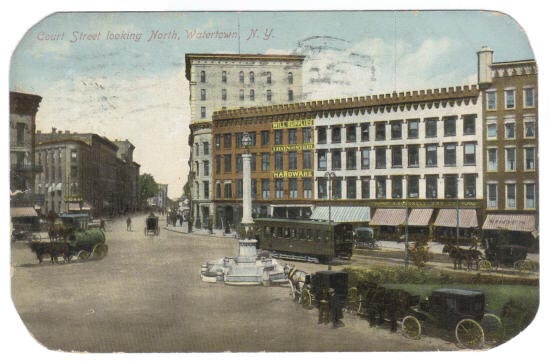
Court Street, looking north, Watertown, New York.
For more examples of
Nellie Roberts Kreischer’s old postcards of Jefferson County, click here.
Another death shocked the Roberts family when “Typhoid fever (gastritis)” claimed the oldest son, Erwin, who died in Watertown on 27 August 1905 at the age of 34. At the time he lived at and was employed as proprietor of the Oakland House on lower Court Street, a hotel whose fortunes and reputation had seen both good and bad days in Watertown’s history. Erwin’s obituary in the Watertown Times read in part: “He was a man of large acquaintance, and his death is sincerely mourned by many friends. Besides his wife, he is survived by his father and mother, Mr. and Mrs. Lewis H. Roberts of this city; one brother, G. L. [sic] Roberts of Brooklyn, and four sisters, Mrs. Harry Danks, Mrs. Jerry LaPatrie [sic], and Mrs. Edward Kelly [sic] of this city, and Mrs. Carl Krichner [sic] of Syracuse.”
Erwin’s funeral was held at the Oakland House, and Erwin was buried next to the grave of his younger brother, Wilbur, in the family plot at North Watertown Cemetery. As far as his wife goes, little is known about her. The 1900 census describes him as a divorced day laborer living with his sister, Clara LaPatra, and her family, but city directories from 1900-1904 show him married and living with a wife named Jenny (living with the LaPatras 1900-1902 and elsewhere afterwards). She seemed to support herself as a dressmaker in Watertown after Erwin’s death, then disappeared from the city directories after 1910.
In these years Lewis and Ellen’s children were grown, supporting their own children, and moving around quite a lot. Most of the sons-in-law seemed to gravitate into working for the railroads in Watertown and elsewhere at one time or another (Nellie and Carl moved to Buffalo for his job with the New York Central for a time, then they settled finally on his parents’ farm in North Syracuse). Harry Danks became custodian of the Watertown city crematory for many years. Lewis and Ellen’s only remaining son, “Joe,” was unique for moving with his family to Brooklyn, NY and becoming a stockbroker. But their girls (other than Nellie, who often visited) and their families remained in Watertown near their parents. Those who remembered the Roberts daughters in Watertown (Etta, Clara, Bessie) described them as being lovely people, high-spirited, full of fun, generous, and socially and family oriented.
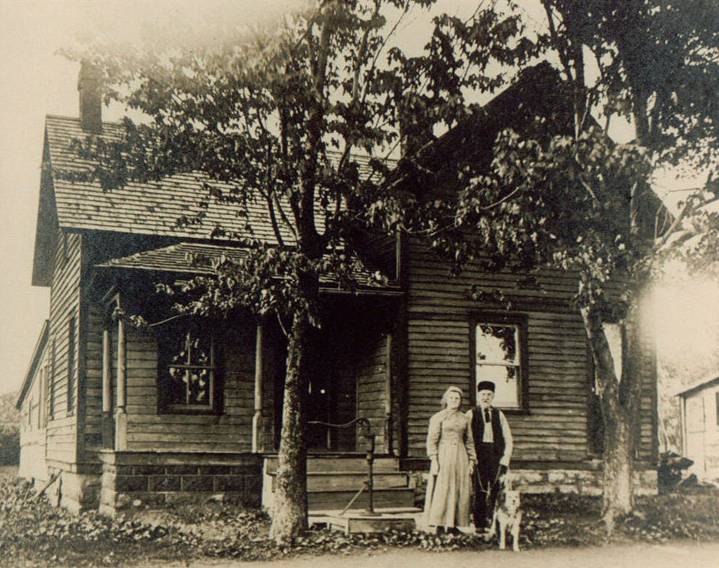
Ellen and “Llewellyn” Roberts. This photo was most probably taken at their farmhouse outside of Sackets Harbor (circa 1905-1910).
In 1910, Bessie and Ed Kelley were living at 18 Duffy Street in Watertown, and may have seen that a nearby house would’ve been a good place for her parents to live. In the final years of their life together, circa 1911-1915, Lewis and Ellen, known to their grandchildren as “Ellen and Llewellyn,” lived at 8 Duffy Street in Watertown, New York.
DEATH date: Friday, December 24, 1915, at the age of 84 years, 9 months, 28 days (also claimed in some sources to have been 85 or 86 years old)
Place: Died at the family home at 8 Duffy Street, Watertown, NY.
Cause: “Chronic Bright’s Disease” (according to Dr. A.E. Ilett, on the record of Death for Lewis H. Roberts included in the Record Proof of Marriages, Births, and Deaths in the Claim of Ellen A. Roberts, wid. for Widow’s Pension, April 11, 1916). Lewis Roberts’ obituary states that he passed away “after a week’s illness, due to pneumonia and a return of troubles resulting from wounds and Bright’s disease [any of several kidney diseases attended with albumin in the urine] contracted in the war.”
BURIAL date: unknown Place: in the family plot in North Watertown Cemetery, Watertown, NY. “Owing to the serious illness of the widow prayers were said privately at the family home and the funeral service was held at [Presbyterian] Faith Chapel. Rev. James H. Keeling officiated.”
Today Lewis and Ellen rest together with their two sons in the quiet refuge of North Watertown Cemetery, just 30-50 yards behind the monument of the Joe Spratt Post G.A.R. Civil War veterans’ burial area. With an American flag emblem and “Late 7th Regt. Wis. V. Arty” carved on his tombstone, he has had commemorated by his family the Civil War service that was the defining event in his life. Ellen’s tombstone has flowers engraved on it. (The three flowers look vaguely like daffodils or narcissus blooms, which would signify rebirth and resurrection). Their daughter, Clara, paid $30 to the cemetery to have the plot cared for in perpetuity.
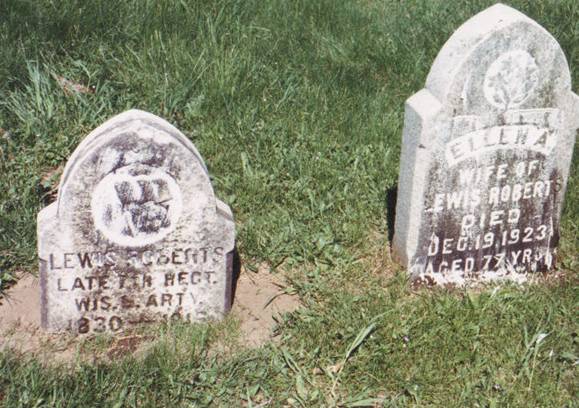
Lewis and Ellen Roberts’ gravemarkers, North Watertown Cemetery
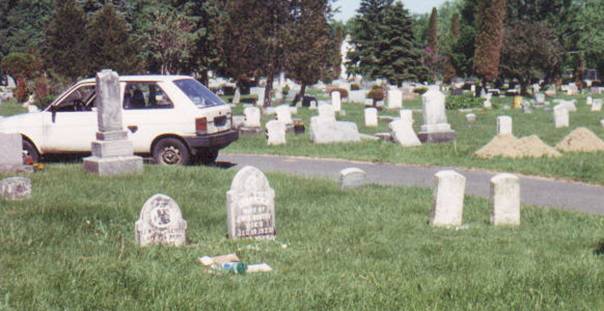
The
Roberts family’s plot, with four gravestones in a row (from left to right):
Lewis and Ellen, then their two sons, Wilbur H. Roberts and Erwin W. Roberts.
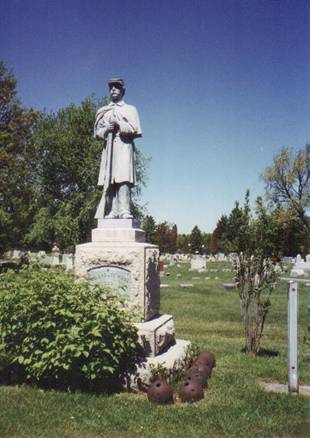
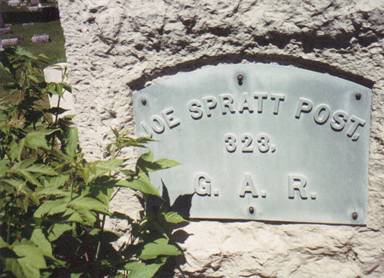
The nearby Joe Spratt Post 323 G.A.R. monument in honor of Civil War veterans at North Watertown Cemetery. Cemetery photos 1994 by M. Stone.
SUMMARY OF RESIDENCES:
1831 - Probably born in Boston (Suffolk Co.), Massachusetts. (Possibly born in Wales; possibly born 1830)
1841-1844 - Probably: Waterloo Street, Dolgelley, Merionethshire, Wales [Dolgellau, Gwynedd; his father was a native of this town]
1846 - Caernarfon, Wales to Boston, Massachusetts, sailing on the barque “Hindoo,” arriving in Boston 15 May.
(Possibly Liverpool, England—possibly 1851 or earlier?)
(Possibly California?)
1851 – marries Margaret Davies in Boston (Suffolk Co.), Massachusetts, 9 December.
1854 - Boston (Suffolk Co.), Massachusetts city directory: “Roberts, Lewis, machinist, boards 5 Mahan place”
1856-1860 - Milwaukee (Milwaukee Co.), Wisconsin, Milwaukee city directory (52 Michigan Street, south side between Milwaukee & Jefferson), Third Ward; U.S. census; also resident of Milwaukee at time of enlistment (11 Nov. 1861); worked as a “machinist” at Decker & Seville
1861-1863 with the Badger State Flying Artillery:
Racine, Wisconsin - Mustered in at Camp Utley, Racine, Nov. 14 1861; stayed with unit there till March 15, 1862; then sent to St. Louis, then to General Pope at New Madrid, Missouri.
Battle of Island No. 10 (Tennessee), April 8, 1862.
On their [7th Wisconsin Batty.] arrival at St. Louis they were ordered to report to General Pope, at New Madrid, the siege of Island No. 10, then being in progress. Moving down the Mississippi River, they landed at Cairo, and proceeded by rail to Sykestown, on the Fulton and Cairo Railroad. From Sykestown, they marched to New Madrid, reporting on the 21st. Here they were employed in the construction and repair of the fortifications along the river, the place having recently been evacuated by the rebels. Detachments were placed in charge of some of the siege guns. After the surrender of Island No. 10, the Seventh Battery was stationed at Fort Bankhead, Fort Harney, and Fort Thompson, near New Madrid. They subsequently moved to Island No. 10, where, on the 13th of June, they received orders to move to Union City, which they reached the next day.
The battery had been furnished with horses and guns [probably those captured from the Rebels at Island No. 10, a resounding victory for the Union] before they left Island No. 10. At Union City, they joined the brigade of General R.M. Mitchell. The battery was stationed, during the summer and fall, first at Trenton, and then at Humboldt [Tennessee], engaged in railroad guard duty....
[pp. 950-951, The Military History of Wisconsin: A Record of the Civil and Military Patriotism of the State, in the War for the Union.... by E.B. Quiner, Esq., Clark & Co., Publishers, 1866.]
Near Humboldt (City), Tennessee - discharged for disability Tuesday, Nov. 18, 1862
South Boston (Suffolk Co.), Massachusetts: lived with his brother, Dr. David Roberts, corner of 4th St. & Dorchester Ave. - Nov. 1862 - Sept. 1863
1863-1868 with the V.R.C.:
Boston and Wenham (Suffolk Co.), Masssachusetts (part of the time at Mason General Hospital and Galloup’s Island, Boston Harbor, with Co. C, 13th Regiment) - Sept. 1863 - c. Dec. 1865
6th Independent Co., Boston, Massachusetts, and David’s Island, New York Harbor, New York - December 1865 – until discharged Aug. 31, 1866
As a civilian: lived in New York City, NY - Winter 1866-67
Boston (Suffolk Co.), Massachusetts - Re-enlisted in the VRC May 6, 1867
Ft. Columbus, New York Harbor with unassigned detachment of men, U.S. Army V.R.C., New York - left June 20, 1867
With the 42nd Regiment, U.S. Infantry, Madison Barracks near Sackets Harbor (Jefferson Co.), New York - unassigned from June 21, 1867; with Company K, 42nd Regiment, U.S. Infantry as of January 10, 1868. Discharged for disability 13 April 1869.
After second marriage and retirement from the service:
Spring 1869 – Summer 1879 - Galloo Island (“Big Galloup”), with P.O. address at Sackets Harbor (acc. to Lewis’ pension records), Jefferson Co., New York. Clara Roberts LaPatra Radley said her family lived halfway between the head and the foot of Big Galloup Island.
Summer 1879 - ? - Lewis, at least, stayed at the home of Morris Hennessy, friend from the Galloo Island sawmill, Watertown (Jefferson Co.), NY until he found own home. Family may have stayed on the island till Fall 1880(?).
1882-1883 - 165 Main [home] “Roberts Lewis H mechanic” Watertown (Jefferson Co.), NY - city directory
1888 - Soldiers and Sailors Home, Bath (Steuben Co.), NY - “Temporarily stopping” - May 21, 1888 (wrote letter from there, Feb. 1888?)
c. June 1887 – 1890, or up to 1895? - #4 Cooper St., Watertown (Jefferson Co.), NY. - Wilbur died there in April 1890; (Watertown City Dir. for 1888-89 and 1889-90 shows Lewis there [p. 43; p. 47]; ibid., p. 135.) Cooper St. ran north from 86 Main to Highland Avenue. #4 was the first number on the east side, across from Cooper Street School, #5. Ibid., for 1895 (pub. 1894), p. 61, shows only “Roberts, Mrs. Ellen” there; Lewis may have gone to one of the Old Soldiers’ Homes.
1888-1890? - Southern Branch, National Home for D.V.S. (Disabled Volunteer Soldiers?) aka National Soldiers and Sailors Home, near Hampton (Elizabeth City), Virginia - Spring 1888 - Special Census of Civil War Vets and Widows finds him there in June, 1890, suffering from Bronchitis.” Said in 1911 to have been “on furlough” there for about 14 years, “which has been extended from time to time every three months” —while giving his address as 8 Duffy St.
1898 - 6 Emmett, Watertown (Jefferson Co.), NY (Watertown city directory for 1898, p. 73: “Roberts, Irwin [sic] W., bds 6 Emmett,” “Roberts, J.L., telegrapher, bds 6 Emmett,” “LaPatra, Jerry, mason, bds 6 Emmett,” “Roberts, Lewis, machinist, h 6 Emmett.” (Emmett Street ran west from 17 Hewitt to 24 Ash; Boon Street and Conger Avenue intersected; No. 6 was on the north side)
1900 - #34 Maple St., Watertown (Jefferson Co.), NY (Watertown city directory for 1900, pub. 1899, p. 258: “Roberts, Lewis, (Ellen) machinist, h 34 Maple” and “Roberts, Mellie [sic] M., res 34 Maple.” (Maple Street ran south from W. Mullin to Pine; the even numbers were on the west side; #34 was two-thirds down the street; also 1900 U.S. census (June 16). Jerome and Maude lived at #38, two doors away)
c. 1901-1911 – After 1900, no longer listed in Watertown city directories. Lewis and Ellen lived on a farm in Election District 1, unincorporated area, Part of Hounsfield Town (“Dexter” Road) in the 1905 and 1910 censuses. Probably along Old Military Road between Storrs and Hess Road, about a mile east outside of Sackets Harbor village
c. 1911-1915 - 8 Duffy Street, Watertown (Jefferson Co.), NY to Lewis Roberts’ death (24 December 1915)
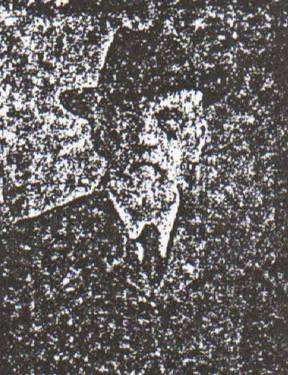
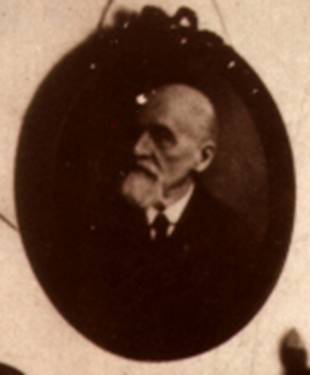
Two poor reproductions of portraits of The Old Soldier, Lewis Humphrey Roberts
| Home |
Rev. 15 Aug. 2008
Copyright
2007, 2008 Michelle Stone. All rights reserved. This information may be used for
personal and/or scholarly research only. Commercial use or reproduction of any
information contained on this website is strictly prohibited. Information
contained on this site is not to appear on any web site on the Internet or in
any printed format without written permission. Please link to my site and give
appropriate copyright credit. Thanks!